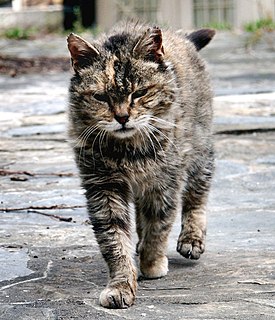
Pasteurellosis is an infection with a species of the bacterial genus Pasteurella, which is found in humans and other animals.
Mycoplasma pneumoniae is a very small bacterium in the class Mollicutes. It is a human pathogen that causes the disease mycoplasma pneumonia, a form of atypical bacterial pneumonia related to cold agglutinin disease. M. pneumoniae is characterized by the absence of a peptidoglycan cell wall and resulting resistance to many antibacterial agents. The persistence of M. pneumoniae infections even after treatment is associated with its ability to mimic host cell surface composition.

Feline immunodeficiency virus (FIV) is a Lentivirus that affects cats worldwide, with 2.5% to 4.4% of felines being infected.

Feline leukemia virus (FeLV) is a retrovirus that infects cats. FeLV can be transmitted from infected cats when the transfer of saliva or nasal secretions is involved. If not defeated by the animal's immune system, the virus weakens the cat's immune system, which can lead to diseases which can be lethal. Because FeLV is cat-to-cat contagious, FeLV+ cats should only live with other FeLV+ cats.

Carnivore protoparvovirus 1 is a species of parvovirus that infects carnivorans. It causes a highly contagious disease in both dogs and cats separately. The disease is generally divided into two major genogroups: CPV-1 containing the classical feline panleukopenia virus (FPLV), and CPV-2 containing the canine parvovirus (CPV) which appeared in the 1970s.

Feline infectious peritonitis (FIP) is the name given to a common and aberrant immune response to infection with feline coronavirus (FCoV).

Canine parvovirus is a contagious virus mainly affecting dogs. CPV is highly contagious and is spread from dog to dog by direct or indirect contact with their feces. Vaccines can prevent this infection, but mortality can reach 91% in untreated cases. Treatment often involves veterinary hospitalization. Canine parvovirus often infects other mammals including foxes, wolves, cats, and skunks. Felines (cats) are also susceptible to panleukopenia, a different strain of parvovirus.
Cerebellar hypoplasia (CH) is a neurological condition in which the cerebellum is smaller than usual or not completely developed. It has been reported in many animal species.
Paroxysmal cold hemoglobinuria (PCH) is an autoimmune hemolytic anemia featured by complement-mediated intravascular hemolysis after cold exposure. It can present as an acute non-recurrent postinfectious event in children, or chronic relapsing episodes in adults with hematological malignancies or tertiary syphilis. Described by Julius Donath (1870–1950) and Karl Landsteiner (1868–1943) in 1904, PCH is one of the first clinical entities recognized as an autoimmune disorder.

Feline viral rhinotracheitis (FVR) is an upper respiratory or pulmonary infection of cats caused by Felid alphaherpesvirus 1 (FeHV-1), of the family Herpesviridae. It is also commonly referred to as feline influenza, feline coryza, and feline pneumonia but, as these terms describe other very distinct collections of respiratory symptoms, they are misnomers for the condition. Viral respiratory diseases in cats can be serious, especially in catteries and kennels. Causing one-half of the respiratory diseases in cats, FVR is the most important of these diseases and is found worldwide. The other important cause of feline respiratory disease is feline calicivirus.

Feline calicivirus (FCV) is a virus of the family Caliciviridae that causes disease in cats. It is one of the two important viral causes of respiratory infection in cats, the other being Felid alphaherpesvirus 1. FCV can be isolated from about 50% of cats with upper respiratory infections. Cheetahs are the other species of the family Felidae known to become infected naturally.
Cat flu is the common name for a feline upper respiratory tract disease. While feline upper respiratory disease can be caused by several different pathogens, there are a few symptoms that they have in common.

Mycoplasma gallisepticum (MG) is a bacterium belonging to the class Mollicutes and the family Mycoplasmataceae. It is the causative agent of chronic respiratory disease (CRD) in chickens and infectious sinusitis in turkeys, chickens, game birds, pigeons, and passerine birds of all ages.

The health of domestic cats is a well studied area in veterinary medicine.
Feline vaccination is animal vaccination applied to cats. Vaccination plays a vital role in protecting cats from infectious diseases, some of which are potentially fatal. They can be exposed to these diseases from their environment, other pets, or even humans.
Feline coronavirus (FCoV) is a positive-stranded RNA virus that infects cats worldwide. It is a coronavirus of the species Alphacoronavirus 1 which includes canine coronavirus (CCoV) and porcine transmissible gastroenteritis coronavirus (TGEV). It has two different forms: feline enteric coronavirus (FECV) that infects the intestines and feline infectious peritonitis virus (FIPV) that causes the disease feline infectious peritonitis (FIP).

Robert Merritt Chanock was an American pediatrician and virologist who made major contributions to the prevention and treatment of childhood respiratory infections in more than 50 years spent at the National Institute of Allergy and Infectious Diseases.

Mycoplasma haemofelis is a gram-negative epierythrocytic parasitic bacterium. It often appears in bloodsmears as small (0.6μm) coccoid bodies, sometimes forming short chains of three to eight organisms. It is usually the causative agent of feline infectious anemia (FIA) in the United States.

Alphacoronavirus 1 is a species of coronavirus that infects cats, dogs and pigs. It includes the virus strains feline coronavirus, canine coronavirus, and transmissible gastroenteritis virus. It is an enveloped, positive-strand RNA virus which is able to enter its host cell by binding to the APN receptor.











